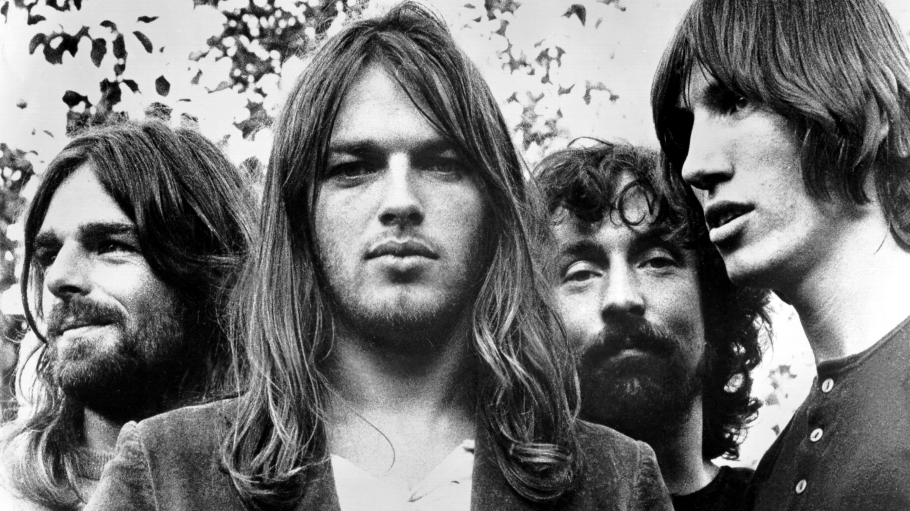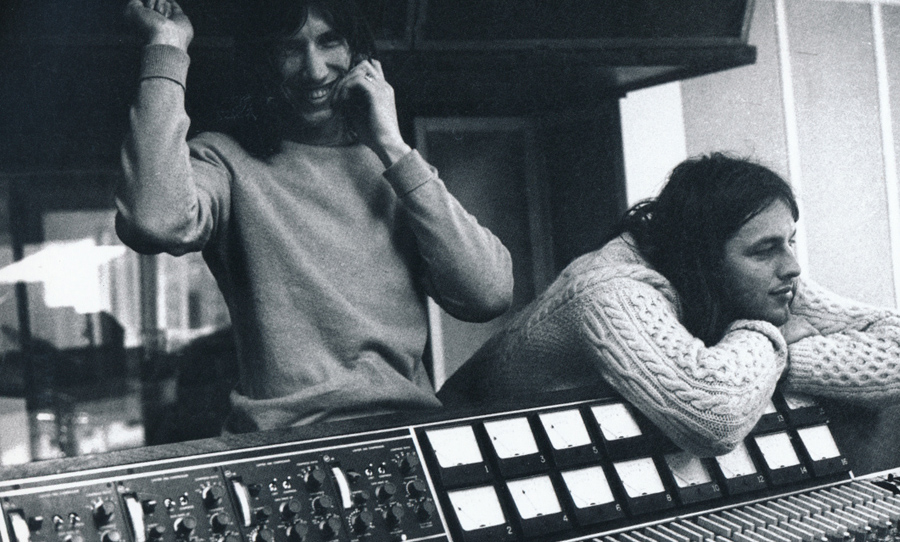
It doesn’t matter whether Pink Floyd’s masterpiece is the best rock album of all time (just as we can agree that there are other worthy contenders for the imaginary throne, including, of course, Sgt. Pepper and Revolver, and Pet Sounds, and any of Hendrix’s three studio albums, or Quadrophenia, Physical Graffiti, London Calling or, back to The Beatles, The White Album or Abbey Road, and don’t forget the Rolling Stones circa ’68-’72, et cetera).
Most reasonable folks, however, will agree that Dark Side of the Moon–released 50 years ago, today–is a pinnacle of what we call prog rock (and while there’s little consensus about what it is or when it began, my thesis is that King Crimson’s seminal In the Court of the Crimson King signaled the official beginning of this new aesthetic, which peaked in the early-to-mid ’70s, limped through the latter years of the decade, and more or less ended on the highest of notes courtesy of Rush’s finest hour, Moving Pictures).
It isn’t that Pink Floyd made some of the best albums of the ‘70s (they did), or that Pink Floyd moved the art form forward (they did); it’s that Pink Floyd did the impossible: they made music that can’t be marginalized, and more than any other band, brought progressive rock into the mainstream. This, along with the unparalleled streak of top tier albums they created, elevates them above all others as the prototypical and most significant prog band.
As much praise as the group rightly receives, they may not be fully appreciated for the ways they changed the future of music. The Dark Side of the Moon did for progressive music what Sgt. Pepper did for rock ‘n’ roll: elevating it from pop to art, and through one indelible and irrevocable triumph, granted authenticity—for all time—to an entire genre. It simply cannot be overstated how meaningful it was, and remains, that one of the best-selling and influential albums in history happens to be the apotheosis of prog rock’s canon. In short, Pink Floyd made it not only possible, but inevitable that other bands would attract more—and more serious—scrutiny, however much many of them suffered by comparison. (My album-by-album analysis of the band’s output can be found at “All Things Reconsidered: Why Not Pink Floyd?”, PopMatters, 11 November 2011.)
Needless to say, The Dark Side of the Moon did not arrive as an abrupt burst of brilliance (great art seldom does) so much as the end result of a long and at times excruciating process, a sort of prog rock apprenticeship. Casual fans may be unaware that Pink Floyd made as many albums before The Dark Side of the Moon as they did after. Even more casual fans may be unaware that Pink Floyd made any albums before The Dark Side of the Moon. Of course, before there was prog rock, there was psychedelic rock. Pink Floyd’s debut, The Piper at the Gates of Dawn (1967) was, in its way, a Sgt. Pepper for the underground, and it remains the most fully realized expression of lysergic-laced pop whimsy: deeply surreal songs you can sing along with.
The initial high from The Piper at the Gates of Dawn proved short-lived as the band’s principal songwriter, troubled genius Syd Barrett, suffered a drug-induced breakdown. (Much more on Syd HERE.) His mate David Gilmour was hastily recruited and, at least at first, did his best Barrett impression. Suffice it to say, no one could—or would—have predicted Pink Floyd’s eventual breakthrough based on their early struggles. As a result of Barrett’s departure two crucial changes occurred: Waters gradually assumed chief lyrical responsibilities and Gilmour became the primary vocalist.
Getting from The Piper at the Gates of Dawn to The Dark Side of the Moon required several years and several albums, none of which sounded especially alike—a fact that seems more remarkable with the benefit of hindsight. Each release, however, had one particular track, often an extended instrumental, that served as a centerpiece that at once set it apart and connected the sonic dots that burst through the prism in 1973: “Interstellar Overdrive” (from The Piper at the Gates of Dawn), “Set the Controls for the Heart of the Sun” (from A Saucerful of Secrets), “Quicksilver” (from More), “The Narrow Way” (from Ummagumma), “Atom Heart Mother Suite” (from Atom Heart Mother) and “Echoes” (from Meddle).
Perhaps the single-most important song Floyd produced during the earliest stages of their extended transitional period is the title track from their second album. The ways in which “A Saucerful of Secrets” expanded and crystallized is documented on the live section from Ummagumma, as well as the definitive version, recorded for their movie Live at Pompeii. Gilmour’s guitar and vocal contributions delineate the ways in which he was asserting himself as a major musical force within the group, forging—along with keyboardist Rick Wright- – an increasingly melodic and ethereal sound.
This performance, recorded just before the sessions for The Dark Side of the Moon commenced, is very much the realization of a sound and style the band had been inching toward, carving away at the stone with each successive effort. The pieces finally came together (or fell apart, if you like) in the form of “Echoes”, the song that officially ended their transition and prepared them to make their masterpiece.

Back when Pink Floyd was the first band in space, they remained mysterious, and cool, by keeping invisible. For being one of the biggest rock groups in the world all through the ‘70s, the average fan would not have recognized any of them in an airport. With few exceptions, their faces weren’t on the album covers, and as the resulting records prove, they always put the music first.
The Dark Side of the Moon is rightly recognized as one of rock music’s most perfect achievements. It also tends to (not unjustifiably) get singled out as the culmination of Pink Floyd’s career. While this may ultimately be the case—and who wants to argue the point?—a more accurate appraisal might be that the group, starting in ’73, locked into a virtuosity that has not been equaled by many, if any other outfits. The four albums released between 1973 and 1979 are among the most discussed, beloved and influential of all time; their collective import remains impossible to overstate.
Dark Side, how do we love thee? Let us count the ways. Perfect opening song. Perfect closing song. No, even that is not quite sufficient praise. No other album begins and ends as sublimely as this one does. From the opening heart beats to the sardonic assertion “There is no dark side of the moon, really…as a matter of fact it’s all dark”, this is rock music’s visionary apex. Dark Side represents the ultimate balance of aesthetic and accessibility—demanding yet consistently satisfying—that The Beatles initiated with Sgt. Pepper. 741 weeks on the charts and it somehow remains invigorating; it is still capable of surprising you, whether it’s the reverb of Gilmour’s slide just before the (improvised) caterwauling on “The Great Gig in the Sky” or the ceaselessly rousing climax of Waters’ understated poetry in “Eclipse” (“And everything under the sun is in tune/But the sun is eclipsed by the moon”). This is it; it’s all in here and it never got better than this.
Bonus, thanks to the desire (or need?) to pad the live material, recorded for the Live at Pompeii documentary/concert (the ideal time capsule of prime Floyd in fighting trim), we have miraculous footage of the Floyd, in studio, creating, tinkering with, and arguing about their “next album” which nobody, certainly including the modest band members, could have predicted would become what it is.
The track that manages to incorporate all these concerns and still address, seemingly everything, is “Time.” The verses, sung with harsh authority by Gilmour, assess (and assail) the concerns and tribulations that preoccupy each of us, while the choruses (rendered as mellow counterpoint by Rick Wright) are crooned, lulling you to sleep, kind of like life will do if you are not paying attention. Special mention must be made of Gilmour’s guitar solo: perhaps it will only sound slightly hysterical to suggest that it, almost impossibly, conjures up so much of the pain and profundity that comprises the human condition; if you close your eyes you can hear the messy miracle of Guns, Germs and Steel. Or maybe it’s just the cold steel rail.
It’s not, in sum, that Pink Floyd became the most visible and best band to carry the progressive rock banner (they were). It’s not that they sold the most albums (they did) and had the best album art (they did—R.I.P. Storm Thorgerson!). It’s that they provided cover, through their influence and example, for smaller, equally brave bands who sought to push past the tedious Top 40 boundaries. By the time 1977 rolled around, space rock seemed as prehistoric as hippies and Johnny Rotten became the punk rock poet laureate, insolently scribbling “I Hate” above his Pink Floyd t-shirt. How much street cred would he have had sporting similar sentiment on a Gentle Giant or Jethro Tull t-shirt?
To this day any band, whether it’s The Flaming Lips, Bjork or Radiohead, who emphasize sound and feeling over accessibility, are in some way emulating the standard Pink Floyd set. The key to understanding Pink Floyd’s magnitude is that they made consistently challenging, progressive music, and still found an audience. Indeed, they did not find an audience so much as their audience found them. Pink Floyd was the first truly underground band to cultivate a sound too remarkable to remain obscured by clouds. They willed themselves to be consequential, and their eminence is undiminished today.
